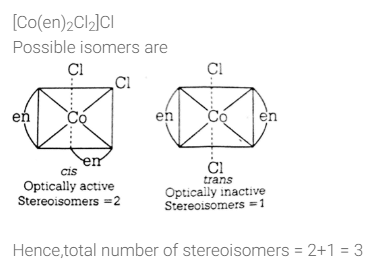All Exams >
NEET >
Inorganic Chemistry for NEET >
All Questions
All questions of Coordination Compounds for NEET Exam
[Ni(CN)4]2- is a type of square planar complex where the oxidation state of Ni is:- a)+2
- b)+1
- c)+4
- d)+3
Correct answer is option 'A'. Can you explain this answer?
[Ni(CN)4]2- is a type of square planar complex where the oxidation state of Ni is:
a)
+2
b)
+1
c)
+4
d)
+3

|
Shreya Bhowate answered |
Let oxidation state of Ni be a.
Therefore, a + (O.S. of CN) x4 = -2
a + (-1 x 4) = -2
a = -2 + 4
a = +2
Therefore, a + (O.S. of CN) x4 = -2
a + (-1 x 4) = -2
a = -2 + 4
a = +2
If zeise’s salt has the formula [Pt(C2H4)CI3]-. In this, platinum primary and secondary valency are- a)+ 1 and 3
- b)+ 1 and 4
- c)+ 3 and 4
- d)+ 4 and 6
Correct answer is option 'B'. Can you explain this answer?
If zeise’s salt has the formula [Pt(C2H4)CI3]-. In this, platinum primary and secondary valency are
a)
+ 1 and 3
b)
+ 1 and 4
c)
+ 3 and 4
d)
+ 4 and 6
|
|
Krishna Iyer answered |
Let the oxidation state of pt be x.
Oxidation state of cl is -1.
So x + 0 – (1*3) must be equal to -1 since the charge of the whole compound is -1.
x + 0 – (1*3) = -1
x -3 = -1
x = -1 + 3
x = +2
So the oxidation state of platinum is +2.
Secondary is due to legend there are mono deadened legend
then 1×4= 4
Oxidation state of cl is -1.
So x + 0 – (1*3) must be equal to -1 since the charge of the whole compound is -1.
x + 0 – (1*3) = -1
x -3 = -1
x = -1 + 3
x = +2
So the oxidation state of platinum is +2.
Secondary is due to legend there are mono deadened legend
then 1×4= 4
Can you explain the answer of this question below:In [Cr(C2O4)3]3_ , the isomerism shown is [AIEEE-2002]
- A:
Ligand
- B:
Optical
- C:
Geometrical
- D:
Ionization
The answer is B.
In [Cr(C2O4)3]3_ , the isomerism shown is [AIEEE-2002]
Ligand
Optical
Geometrical
Ionization
|
|
Ritu Singh answered |
The correct answer is B.
[Cr(Ox)3]3− Ox = C2O42−
[Cr(Ox)3]3− Ox = C2O42−
Optical Isomer ⟶ Non-superimposable mirror images
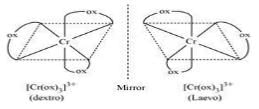

The correct IUPAC name of the complex Fe(C5H5)2 is _- a)Cyclopentadienyl iron (II)
- b)Bis (cyclopentadienyl) iron (II)
- c)Dicyclopentadiency ferrate (II)
- d)Ferrocene
Correct answer is option 'B'. Can you explain this answer?
The correct IUPAC name of the complex Fe(C5H5)2 is _
a)
Cyclopentadienyl iron (II)
b)
Bis (cyclopentadienyl) iron (II)
c)
Dicyclopentadiency ferrate (II)
d)
Ferrocene
|
|
Alok Mehta answered |
The iron complex may be treated as cationic part, and C5H5- is a bidentate ligand therefore name can be assigned as follows “dicyclopentadienyl Iron (II) cation”.
Which one of the following complexes in an outer orbitals complex– [AIEEE-2004]- a) [Co(NH3)6]3+
- b) [Mn(CN)6]4_
- c)[Fe(CN)6]4_
- d) [Ni(NH3)6]2+
Correct answer is option 'D'. Can you explain this answer?
Which one of the following complexes in an outer orbitals complex– [AIEEE-2004]
a)
[Co(NH3)6]3+
b)
[Mn(CN)6]4_
c)
[Fe(CN)6]4_
d)
[Ni(NH3)6]2+
|
|
Suresh Iyer answered |
The correct answer is option D
Generally weaker field ligands form outer orbital complexes.
CN− is a very strong ligand and NH3 is a weak ligand.
So [Co(NH3)6]3+ and [Ni(NH3)6]2+ can form an outer orbital complex.
Electronic configuration of Co+3 is [Ar]3d64s0
Electronic configuration of Ni+2 is [Ar]3d84s0
Nickel complexes can form due to presence of d8 configuration.
Generally weaker field ligands form outer orbital complexes.
CN− is a very strong ligand and NH3 is a weak ligand.
So [Co(NH3)6]3+ and [Ni(NH3)6]2+ can form an outer orbital complex.
Electronic configuration of Co+3 is [Ar]3d64s0
Electronic configuration of Ni+2 is [Ar]3d84s0
Nickel complexes can form due to presence of d8 configuration.
In the complex PtCl4 . 5NH3 if coordination number of platinum is 6, number of chloride ions precipitated by adding AgNO3 are
Correct answer is '3'. Can you explain this answer?
In the complex PtCl4 . 5NH3 if coordination number of platinum is 6, number of chloride ions precipitated by adding AgNO3 are
|
|
Poulomi Desai answered |
Coordination number of platinum is 6.
∴ Number of chloride ions precipitated by adding AgCI are 3.
∴ Number of chloride ions precipitated by adding AgCI are 3.
Type of bonding in K4 [Fe(CN)6] is/a- a)ionic
- b)covalent
- c)metallic
- d)coordinate covalent
Correct answer is option 'A,B,D'. Can you explain this answer?
Type of bonding in K4 [Fe(CN)6] is/a
a)
ionic
b)
covalent
c)
metallic
d)
coordinate covalent
|
|
Shubham Jain answered |
The complex K4[Fe(CN)6] whose formula can be written like that of double salt. Fe(CN)2 . 4KCN, dissociates to give K+ and [Fe(CN)6]4- ions in the aqueous solution.

The magnetic moment of [Ru(H2O)6]2+ corresponds to the presence of ...... unpaired electrons.
Correct answer is '4'. Can you explain this answer?
The magnetic moment of [Ru(H2O)6]2+ corresponds to the presence of ...... unpaired electrons.

|
Anuj Iyer answered |
Ru2+ =[Kr] 4d6. This forms outer complex. Hence, unpaired electrons are 4.
The IUPAC name of [Ni(PPh3)2CI2]2+ is- a)bis dichloro(triphenylphosphine) nickel (II) ion
- b)dichloro bis (triphenylphosphine) nickel (ll)ion
- c)dichloro triphenylphosphine nickel (II) ion
- d)triphenylphosphine nickel (ll)dichloride
Correct answer is 'B'. Can you explain this answer?
The IUPAC name of [Ni(PPh3)2CI2]2+ is
a)
bis dichloro(triphenylphosphine) nickel (II) ion
b)
dichloro bis (triphenylphosphine) nickel (ll)ion
c)
dichloro triphenylphosphine nickel (II) ion
d)
triphenylphosphine nickel (ll)dichloride
|
|
Aravind Rane answered |
The IUPAC name of [Ni(PPh3)CI2]2+ is dichlo ro bis (triphenylphosphine) nickel (II) ion.
Earth's atmosphere is richest in :- a)ultraviolet
- b)infrared
- c)X-rays
- d)microwaves
Correct answer is option 'B'. Can you explain this answer?
Earth's atmosphere is richest in :
a)
ultraviolet
b)
infrared
c)
X-rays
d)
microwaves
|
|
Geetika Shah answered |
The correct answer is Option B.
Earth 's atmosphere is richest in infrared radiation or IR.
* The earth emits huge amounts of infrared radiation and thereby makes the atmosphere richest in infrared rays.
* When sunlight (solar radiation) hits the earth, some of the energy is absorbed by the earth that ultimately heats up the earth.
* This heat gets radiated by the earth in the form of infrared radiation.
Earth 's atmosphere is richest in infrared radiation or IR.
* The earth emits huge amounts of infrared radiation and thereby makes the atmosphere richest in infrared rays.
* When sunlight (solar radiation) hits the earth, some of the energy is absorbed by the earth that ultimately heats up the earth.
* This heat gets radiated by the earth in the form of infrared radiation.
Coordination compounds have great importance in biological systems. In this contect which of the following statements is incorrect ? [AIEEE-2004]- a)Cyanocobalamin is vitamin B12 and contains cobalt
- b)Haemoglobin is the red pigment of blood and contains iron
- c)Chlorophylls are green pigments in plants and contain calcium
- d)Carboxypeptidase-A is an enzyme and contains zinc
Correct answer is option 'C'. Can you explain this answer?
Coordination compounds have great importance in biological systems. In this contect which of the following statements is incorrect ?
[AIEEE-2004]
a)
Cyanocobalamin is vitamin B12 and contains cobalt
b)
Haemoglobin is the red pigment of blood and contains iron
c)
Chlorophylls are green pigments in plants and contain calcium
d)
Carboxypeptidase-A is an enzyme and contains zinc

|
Sanika Shaikh answered |
Option B is correct not c
if c is correct then instead of calcium the magnesium should be .
if c is correct then instead of calcium the magnesium should be .
Ferrocyanide ion is a type of- a)Square planar complex
- b)Octahedral complex
- c)Tetrahedral complex
- d)Octahedral square planar complex
Correct answer is option 'B'. Can you explain this answer?
Ferrocyanide ion is a type of
a)
Square planar complex
b)
Octahedral complex
c)
Tetrahedral complex
d)
Octahedral square planar complex
|
|
Rajeev Saxena answered |
Ferricyanide is the anion [Fe(CN)6]3−. It is also called hexacyanoferrate(III) and in rare, but systematic nomenclature, hexacyanidoferrate(III). The most common salt of this anion is potassium ferricyanide, a red crystalline material that is used as an oxidant in organic chemistry.
A magnetic moment of 1.73 BM will be shown by one among the following- a)[Cu(NH3)4]2+
- b)[Ni(CN)4]2–
- c)TiCl4
- d)[CoCl6]4–
Correct answer is option 'A'. Can you explain this answer?
A magnetic moment of 1.73 BM will be shown by one among the following
a)
[Cu(NH3)4]2+
b)
[Ni(CN)4]2–
c)
TiCl4
d)
[CoCl6]4–
|
|
Ritu Singh answered |
The correct answer is Option A.
Electronic configuration of Cu2+ ion in [Cu(NH3)4]2+.
Cu2+ ion =[Ar]3d94s0.
∴Cu2+ ion has one unpaired electron.
Magnetic moment of [Cu(NH3)4]2+ (μ) = BM
BM
where, n = no. of unpaired electrons

Whereas Ni2+ in [Ni(CN)4]2− , Ti4+ in TiCl4 and Co2+ ion [COCl6]4− has 2,0 and 3 unpaired electrons respectively.
Electronic configuration of Cu2+ ion in [Cu(NH3)4]2+.
Cu2+ ion =[Ar]3d94s0.
∴Cu2+ ion has one unpaired electron.
Magnetic moment of [Cu(NH3)4]2+ (μ) =
 BM
BMwhere, n = no. of unpaired electrons

Whereas Ni2+ in [Ni(CN)4]2− , Ti4+ in TiCl4 and Co2+ ion [COCl6]4− has 2,0 and 3 unpaired electrons respectively.
One or More than One Options Correct TypeDirection (Q. Nos. 11-15) This section contains 5 multiple choice questions. Each question has four choices (a), (b), (c) and (d), out of which ONE or MORE THAN ONE are correct.Q. Which of the following complexes have correct name?- a)K [Pt(NH3)CI5] = potassiumamminepentachloridoplatinate (IV)
- b)[Ag(CN)2]- = dicyanidoargentate(l) ion
- c)K3[Cr(C2O4)3] = tripotassium trioxalatochromate(lll)
- d)Na2[Ni(EDTA)] = sodium ethylenediaminetetraacetatonickel(ll)
Correct answer is option 'A,B'. Can you explain this answer?
One or More than One Options Correct Type
Direction (Q. Nos. 11-15) This section contains 5 multiple choice questions. Each question has four choices (a), (b), (c) and (d), out of which ONE or MORE THAN ONE are correct.
Q.
Which of the following complexes have correct name?
a)
K [Pt(NH3)CI5] = potassiumamminepentachloridoplatinate (IV)
b)
[Ag(CN)2]- = dicyanidoargentate(l) ion
c)
K3[Cr(C2O4)3] = tripotassium trioxalatochromate(lll)
d)
Na2[Ni(EDTA)] = sodium ethylenediaminetetraacetatonickel(ll)
|
|
Mira Joshi answered |
Complexes K[Pt(NH3)Cl5] and [Ag(CN)2]- have been given their respective IUPAC names.
The IUPAC name of the complex [(CO)5Mn - Mn(CO)5] is- a)bis (pentacarbonyl dimanganese)
- b)bis (pentacarbonyldimanganate(ll)
- c)decacarbonyldimanganate (0).
- d)bis (pentacarbonyldimanganese(O)
Correct answer is option 'C'. Can you explain this answer?
The IUPAC name of the complex [(CO)5Mn - Mn(CO)5] is
a)
bis (pentacarbonyl dimanganese)
b)
bis (pentacarbonyldimanganate(ll)
c)
decacarbonyldimanganate (0).
d)
bis (pentacarbonyldimanganese(O)
|
|
Gaurav Kumar answered |
Decacarbonyldimanganese (0), Mn2(CO)10, is made up of two square pyramidal Mn(CO)5 units joined by a Mn-Mn bond.
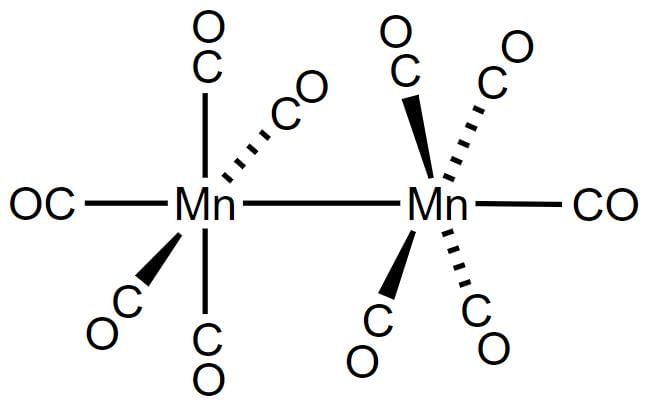
The spin only magnetic moment value (in Bohr magneton units) of Cr(CO)6 is- a)0
- b)2.84
- c)4.90
- d)5.92
Correct answer is option 'A'. Can you explain this answer?
The spin only magnetic moment value (in Bohr magneton units) of Cr(CO)6 is
a)
0
b)
2.84
c)
4.90
d)
5.92
|
|
Rahul Bansal answered |
The electron configuration is [Ar]3d^5 4s^1.We have to accomodate the 6 Ligands and the fact that CO is a strong ligand.
This results in d^2sp^3 hybridization. Therefore, there are no unpaired electrons in Cr(CO)6. Hence n=0
And the spin only magnetic moment is also 0.
The correct order of magnetic moments (spin only values in B.M. among is) – [AIEEE-2004]- a)[Fe(CN)6]4_ > [MnCl4]2_ > [CoCl4]2_
- b)[MnCl4]4_ > [Fe(CN)6]4_ > [CoCl4]2_
- c)[MnCl4]2_ > [CoCl4]2_ > [Fe(CN)6]4_
- d)[Fe(CN)6]4_ > [CoCl4]2_ > [MnCl4]2_
Correct answer is option 'C'. Can you explain this answer?
The correct order of magnetic moments (spin only values in B.M. among is) –
[AIEEE-2004]
a)
[Fe(CN)6]4_ > [MnCl4]2_ > [CoCl4]2_
b)
[MnCl4]4_ > [Fe(CN)6]4_ > [CoCl4]2_
c)
[MnCl4]2_ > [CoCl4]2_ > [Fe(CN)6]4_
d)
[Fe(CN)6]4_ > [CoCl4]2_ > [MnCl4]2_
|
|
Vivek Rana answered |
The correct answer is option C
Cl− is a weak ligand while CN− is a strong ligand.
In [MnCl4]2: d5 configuration and 5 unpaired electrons
In [CoCl4]2: d7 configuration and 3 unpaired electrons
In [Fe(CN)6]4: d6 configuration, low spin complex and 0 unpaired electrons
More the number of unpaired electrons, more the value of magnetic moment. Hence, the order is: [MnCl4]2−>[CoCl4]2−>[Fe(CN)6]4−
Cl− is a weak ligand while CN− is a strong ligand.
In [MnCl4]2: d5 configuration and 5 unpaired electrons
In [CoCl4]2: d7 configuration and 3 unpaired electrons
In [Fe(CN)6]4: d6 configuration, low spin complex and 0 unpaired electrons
More the number of unpaired electrons, more the value of magnetic moment. Hence, the order is: [MnCl4]2−>[CoCl4]2−>[Fe(CN)6]4−
The effective atomic number of Fe in Fe(CO)5 is- a)36
- b)24
- c)34
- d)26
Correct answer is option 'A'. Can you explain this answer?
The effective atomic number of Fe in Fe(CO)5 is
a)
36
b)
24
c)
34
d)
26

|
Anupama Nair answered |
EAN= atomic no of Fe - oxidation state + no of e donated by ligand... Oxidation state of Fe is 0 since CO is neutral ligand... Two donor atoms hence no of e = 2×5=10.... EAN= 26-0+10=36
The number of unpaired electrons in [V(H2O)6]3+ is:- a)1
- b)4
- c)3
- d)2
Correct answer is 'D'. Can you explain this answer?
The number of unpaired electrons in [V(H2O)6]3+ is:
a)
1
b)
4
c)
3
d)
2
|
|
Krishna Iyer answered |
The metal ion V3+ is in +3 oxidation state, with configuration d2, and the hybridization of metal ion orbitals for ligand bond is d2sp3, where the number of unpaired electrons in [V(H2O)6]3+ is 2.
Tollen’s reagent contains- a)AgOH
- b)AgNO3
- c)[Ag(NO3)2]+
- d)[Ag(NH3)2]+
Correct answer is option 'B'. Can you explain this answer?
Tollen’s reagent contains
a)
AgOH
b)
AgNO3
c)
[Ag(NO3)2]+
d)
[Ag(NH3)2]+

|
Akash Shah answered |
Toilen’s reagent is ammoniacal silver nitrate solution. It is used to distinguish aldehydes and ketones, reducing and non-reducing sugars.
The formula of the complex hexamminecobalt (III) chloride sulphate is- a)[Co(NH3)6]CISO4
- b)[Co(NH3)6CI]SO4
- c)[Co(NH3)6CISO4]
- d)None of these
Correct answer is 'A'. Can you explain this answer?
The formula of the complex hexamminecobalt (III) chloride sulphate is
a)
[Co(NH3)6]CISO4
b)
[Co(NH3)6CI]SO4
c)
[Co(NH3)6CISO4]
d)
None of these
|
|
Anshika Menon answered |
Formula of Complex Hexamminecobalt (III) Chloride Sulphate
The correct answer is 'A' which represents the formula [Co(NH3)6]ClSO4. Let's break down the answer into the following headings:
I. Understanding the Formula
II. Explanation of the Formula
III. Conclusion
I. Understanding the Formula
Before we dive into the formula, let's understand some key terms:
- Complex: A molecule or ion formed by the combination of a metal ion with a ligand (a molecule or ion that can donate a pair of electrons to the metal ion)
- Hexamminecobalt (III) chloride: A complex formed by the combination of cobalt (III) ion with six ammonia molecules and one chloride ion
- Sulphate: A compound containing the sulphate ion (SO4 2-)
II. Explanation of the Formula
The given complex contains cobalt (III) ion, six ammonia molecules (NH3), one chloride ion (Cl-), and one sulphate ion (SO4 2-). The cobalt (III) ion is coordinated by six ammonia molecules forming an octahedral complex. The chloride ion and sulphate ion occupy the remaining two positions of the octahedral complex. Therefore, the formula of the complex is [Co(NH3)6]ClSO4.
III. Conclusion
In conclusion, the formula of the complex hexamminecobalt (III) chloride sulphate is [Co(NH3)6]ClSO4. The complex contains cobalt (III) ion coordinated by six ammonia molecules, one chloride ion, and one sulphate ion.
The correct answer is 'A' which represents the formula [Co(NH3)6]ClSO4. Let's break down the answer into the following headings:
I. Understanding the Formula
II. Explanation of the Formula
III. Conclusion
I. Understanding the Formula
Before we dive into the formula, let's understand some key terms:
- Complex: A molecule or ion formed by the combination of a metal ion with a ligand (a molecule or ion that can donate a pair of electrons to the metal ion)
- Hexamminecobalt (III) chloride: A complex formed by the combination of cobalt (III) ion with six ammonia molecules and one chloride ion
- Sulphate: A compound containing the sulphate ion (SO4 2-)
II. Explanation of the Formula
The given complex contains cobalt (III) ion, six ammonia molecules (NH3), one chloride ion (Cl-), and one sulphate ion (SO4 2-). The cobalt (III) ion is coordinated by six ammonia molecules forming an octahedral complex. The chloride ion and sulphate ion occupy the remaining two positions of the octahedral complex. Therefore, the formula of the complex is [Co(NH3)6]ClSO4.
III. Conclusion
In conclusion, the formula of the complex hexamminecobalt (III) chloride sulphate is [Co(NH3)6]ClSO4. The complex contains cobalt (III) ion coordinated by six ammonia molecules, one chloride ion, and one sulphate ion.
Which of the following statements is/are correct?- a)[Co(en)2NO2Cl] Br is cationic complex
- b)[Co(en)3]CI3 produces 3 ions in solution
- c)[Fe(CO)5] is neutral complex
- d)[Cu(NH3)4]SO4 is deep blue colour
Correct answer is option 'A,C,D'. Can you explain this answer?
Which of the following statements is/are correct?
a)
[Co(en)2NO2Cl] Br is cationic complex
b)
[Co(en)3]CI3 produces 3 ions in solution
c)
[Fe(CO)5] is neutral complex
d)
[Cu(NH3)4]SO4 is deep blue colour
|
|
Nikita Singh answered |
[Co(en)3]CI3 produces 4 ions in solution as follows :
[Co(en)3] CI3→ [Co(en)3]3+ + 3CI-
[Co(en)3] CI3→ [Co(en)3]3+ + 3CI-
- is correct as charge on the complex ion will be +1
- is incorrect as the complex will form 4 ions in solution
- is correct as there is no charge on the complex
- is also correct as cu+2 has blue color in solution
Hence A, C and D are correct.
The complex, [Ni(CN)4]2-, has:
- a)Octahedral structure
- b)Linear structure
- c)Tetrahedral structure
- d)Square planar Structure
Correct answer is option 'D'. Can you explain this answer?
The complex, [Ni(CN)4]2-, has:
a)
Octahedral structure
b)
Linear structure
c)
Tetrahedral structure
d)
Square planar Structure
|
|
Naina Bansal answered |
In case of [Ni(CN)4 ]^2-, oxidation state of Nickel is +2. So, Ni^2+ : 3d^8 4s^0 . Now, cyanide also causes pairing of unpaired electrons, in 3d orbital, all the 8 electrons will get paired, so now, 1 more orbital is left.... and there are 4 ligands to bond with. Hence, the hybridization will be dsp^2 so hence, it is a square planar complex because all dsp^2 complexes are square planar. The singly unpaired electron will pair up only if the ligand field is very strong and that too only in the lower energy orbitals.
Which one of the following is expected to exhibit optical isomerism? (en = eth ylen ediamine) [2 00 5]- a)cis [Pt(NH3)2 Cl2]
- b)trans [Pt(NH3)2Cl2]
- c)cis [Co(en)2Cl2]
- d)trans [Co(en)2Cl2]
Correct answer is option 'C'. Can you explain this answer?
Which one of the following is expected to exhibit optical isomerism? (en = eth ylen ediamine) [2 00 5]
a)
cis [Pt(NH3)2 Cl2]
b)
trans [Pt(NH3)2Cl2]
c)
cis [Co(en)2Cl2]
d)
trans [Co(en)2Cl2]

|
Shivani Rane answered |
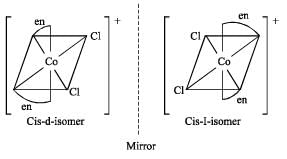
Transform of [M(AA)2 a2]n± does not shows optical isomerism.
IUPAC name of [Pt(NH3)2Cl(NO2)] is - a)Platinum diamminechloronitrite
- b)Chloronitrito-N-ammineplatinum (II)
- c)Diamminechloridonitrito-N-platinum (II)
- d)Diamminechloronitrito-N-plantinate (II)
Correct answer is option 'C'. Can you explain this answer?
IUPAC name of [Pt(NH3)2Cl(NO2)] is
a)
Platinum diamminechloronitrite
b)
Chloronitrito-N-ammineplatinum (II)
c)
Diamminechloridonitrito-N-platinum (II)
d)
Diamminechloronitrito-N-plantinate (II)
|
|
Rajesh Gupta answered |
Ans: c
Explanation:Pt(NH3)2Cl(NO2)
m − 2 = 0
m = +2
(NH3)2 ⇒ Diammine
Cl ⇒ Chlorido
NO2 ⇒ Nitrito-N.
So, IUPAC NAME: diamminechloridonitrito-N-platinum(II)
The hybrisation of Co in [Co(H2O)6]3+ is :
- a)d2sp3
- b)dsp2
- c)dsp3
- d)spd3
Correct answer is option 'A'. Can you explain this answer?
The hybrisation of Co in [Co(H2O)6]3+ is :
a)
d2sp3
b)
dsp2
c)
dsp3
d)
spd3
|
|
Rajeev Saxena answered |
In this complex compound the total charge is +3 as H2O is a neutral compound so the oxidation state of cobalt is +3 and the electronic configuration of Co is 3d7 4s2. So, Co(+3)=4d6 and H2O is a weak ligand so there is no pairing of electron. So,4s 4p3 and 4d2 orbital make hybrid orbital to have a hybridization of d2sp3.
A freshly prepared aqueous solution of Pd(NH3)2CI2 does not conduct electricity, it suggests that- a)the structure of the compound involves covalent bonding only
- b)the chlorine atoms must be in coordination sphere
- c)the van't Hoff factor of the compound would be unity
- d)on adding excess aqueous AgNO3 to 0.1 L of 0.1 M solution of the compound, 0.02 mole of AgCI would be obtained
Correct answer is option 'B,C'. Can you explain this answer?
A freshly prepared aqueous solution of Pd(NH3)2CI2 does not conduct electricity, it suggests that
a)
the structure of the compound involves covalent bonding only
b)
the chlorine atoms must be in coordination sphere
c)
the van't Hoff factor of the compound would be unity
d)
on adding excess aqueous AgNO3 to 0.1 L of 0.1 M solution of the compound, 0.02 mole of AgCI would be obtained

|
Sankar Chakraborty answered |
In the aqueous solution of Pd(NH3)2CI2, the atoms of chlorine I are in coordination sphere and the van't Hoff factor of the ] compound are unite.
Complex compounds are addition compounds formed by the stoichiometric combination of two or more simple salts but do not decompose into constituent ions completely. The first such complex prepared by Tassaert is hexamine cobalt (III) chloride. Later many such compounds were prepared and their properties were studied. The chloramines complexes of cobalt (III) chromium (III) not only exhibit a spectrum of colours but also differ in the reactivity of their chlorides. Moreover, greater the number of ions produced by a complex in solution, greater is the electrical conductivity. This type of information was obtained for several series of complexes.Q. The number of ions per mole of the complex CoCI3 . 5NH3 in aqueous solution will be- a)3
- b)9
- c)2
- d)4
Correct answer is option 'A'. Can you explain this answer?
Complex compounds are addition compounds formed by the stoichiometric combination of two or more simple salts but do not decompose into constituent ions completely. The first such complex prepared by Tassaert is hexamine cobalt (III) chloride. Later many such compounds were prepared and their properties were studied. The chloramines complexes of cobalt (III) chromium (III) not only exhibit a spectrum of colours but also differ in the reactivity of their chlorides. Moreover, greater the number of ions produced by a complex in solution, greater is the electrical conductivity. This type of information was obtained for several series of complexes.
Q.
The number of ions per mole of the complex CoCI3 . 5NH3 in aqueous solution will be
a)
3
b)
9
c)
2
d)
4
|
|
Suresh Iyer answered |
[Co(NH3)5CI]CI2→[Co(NH3)5CI]2++ 2Cl-
Hence, 3 ions are present for one mole of the complex in the solution.
Hence, 3 ions are present for one mole of the complex in the solution.
23. One projectile moving with velocity v in space get burst into 2 parts of masses in the ratio of 1 : 2. The smaller part becomes stationary, velocity of other part is : - a)uv
- b)3v/2
- c)4v/3
- d)2v/3
Correct answer is option 'B'. Can you explain this answer?
23. One projectile moving with velocity v in space get burst into 2 parts of masses in the ratio of 1 : 2. The smaller part becomes stationary, velocity of other part is :
a)
uv
b)
3v/2
c)
4v/3
d)
2v/3
|
|
Geetika Shah answered |
Let the mass =m
Apply law of momentum conservation
mv = m/4*0 + 2mv1/3
v = 2v1/3
v1 = 3v/2
Apply law of momentum conservation
mv = m/4*0 + 2mv1/3
v = 2v1/3
v1 = 3v/2
The IUPAC name of the compound [Cr(NH3)5(NCS)][ZnCI4] is- a)pentammine isothiocyanatochromium (III) tetrachlorozincate (II)
- b)pentaammine thiocyanatochromium (III) tetrachlorozincate (II)
- c)pentammine isothiocyanatochromium (0) tetrachlorozincate (IV)
- d)pentammine thiocyanatochromium (0) tetrachlorozincate (IV
Correct answer is option 'A'. Can you explain this answer?
The IUPAC name of the compound [Cr(NH3)5(NCS)][ZnCI4] is
a)
pentammine isothiocyanatochromium (III) tetrachlorozincate (II)
b)
pentaammine thiocyanatochromium (III) tetrachlorozincate (II)
c)
pentammine isothiocyanatochromium (0) tetrachlorozincate (IV)
d)
pentammine thiocyanatochromium (0) tetrachlorozincate (IV

|
Avantika Joshi answered |
The lUPAC name of [Cr(NH3)5(NCS)][ZnCI4] is pentammine isothiocyanatochromium (III) tetrachlorozincate (II).
Which of the following complex ion is not expected to absorb visible light ? [2010]- a)Ni(CN)42
- b)Cr(NH3)6 3
- c)2Fe(H2 O)6
- d)Ni(H2O)62
Correct answer is option 'A'. Can you explain this answer?
Which of the following complex ion is not expected to absorb visible light ? [2010]
a)
Ni(CN)42
b)
Cr(NH3)6 3
c)
2Fe(H2 O)6
d)
Ni(H2O)62

|
Mahesh Saini answered |
Absorption of visual light is associated with an energy difference between two orbitals — one occupied, one unoccupied — and electrons must be able to be excited from one to the other.
In coordination complexes, these excitations typically happen within the metal’s d subshell, so it is usually sufficient to examine that and approximately determine which excitations are possible. The main selection rules are:
the spin rule. The electron must be excitable without a spin-flip
the Laporte rule. Basically, d to d transitions are forbidden in octahedral complexes
The spin rule is very strongly observed. The color of manganese(II) whose transition is spin-forbidden is extremely faint. The Laporte rule only holds true as long as the complex is inversion-symmetric, so any asymmetric vibration is enough to make it void; thus, Laporte-forbidden transitions are typically still visible but somewhat faint.
Let’s examine the complexes:
[Ni(CN)4]2−This is expected to be square planar and d8. The energy difference between the two highest orbitals — dxy and dx2−y2 — is expected to be high. The former is expected to be fully populated, the latter to be unpopulated.
[Cr(NH3)6]3+ This is a d3 system. It is expected to be octahedral with a standard difference between the lower and higher energy levels.
[Fe(H2O)6]2+This is a d6 octahedral system. There is no reason to assume a low spin state. The energy difference is expected to be slightly less than in the previous case.
[Ni(H2O)6]2+ this is expected to be a high-spin d8system and octahedral. The same expectation regarding energy levels as on the previous case applies.
We realize that the of our complexes are average high spin octahedral complexes. For these, visible light absorption is always expected. Only one case is different. In that different case, the HOMO-LUMO difference is large. While we can still expect absorption, it seems most reasonable to assign this absorption band an ultraviolet wavelength.
Thus, [Ni(CN)4]2− is the answer.
The complex potassium dicyanodioxalatonickelate (II) in solution produce....... ions.
Correct answer is '5'. Can you explain this answer?
The complex potassium dicyanodioxalatonickelate (II) in solution produce....... ions.
|
|
Anaya Patel answered |
The structure of potassium dicyanodio xalatonickelate (II) is
K4[Ni(CN)2(ox)2].
K4[Ni(CN)2(ox)2] → 4K+ + [Ni(CN)2(ox)2]-
This produce 5 ions in solution.
K4[Ni(CN)2(ox)2].
K4[Ni(CN)2(ox)2] → 4K+ + [Ni(CN)2(ox)2]-
This produce 5 ions in solution.
Ammonia forms the complex ion [Cu(NH3)4]2+ ion with copper ions in alkaline solutions but not in acidic solution. What is the reason for it – [AIEEE-2003]- a) In acidic solution hydration protects copper ions
- b)In acidic solutions protons coordinate with ammonia molecules forming NH4+ ions and NH3 molecules are not available
- c)In alkaline solutions insoluble Cu(OH)2 is precipitated which is soluble in excess of any alkali
- d)Copper hydroxide is an amphoteric substance
Correct answer is option 'B'. Can you explain this answer?
Ammonia forms the complex ion [Cu(NH3)4]2+ ion with copper ions in alkaline solutions but not in acidic solution. What is the reason for it – [AIEEE-2003]
a)
In acidic solution hydration protects copper ions
b)
In acidic solutions protons coordinate with ammonia molecules forming NH4+ ions and NH3 molecules are not available
c)
In alkaline solutions insoluble Cu(OH)2 is precipitated which is soluble in excess of any alkali
d)
Copper hydroxide is an amphoteric substance

|
Divey Sethi answered |
The correct answer is option B
In acidic solutions, ammonia reacts with proton and forms ammonium ion which further cannot act as a ligand. Also, no free ammonia molecules are available for co-ordination. Hence, it does not form a complex with copper ion.
The reaction is as follows:
NH3 + H+ → NH4+
In acidic solutions, ammonia reacts with proton and forms ammonium ion which further cannot act as a ligand. Also, no free ammonia molecules are available for co-ordination. Hence, it does not form a complex with copper ion.
The reaction is as follows:
NH3 + H+ → NH4+
What is the IUPAC name of compound NaBH4?- a)Sodium boronhydride
- b)Sodium tetrahydridoboron (III)
- c)Sodium tetrahydridoborate (III)
- d)Sodium tetrahydridoborate (I)
Correct answer is option 'C'. Can you explain this answer?
What is the IUPAC name of compound NaBH4?
a)
Sodium boronhydride
b)
Sodium tetrahydridoboron (III)
c)
Sodium tetrahydridoborate (III)
d)
Sodium tetrahydridoborate (I)
|
|
Hansa Sharma answered |
Common name of NaBH4 is sodium borohydride
IUPAC name of NaBH4is sodium tetrahydridoborate{III}
In the complex PtCl4.3NH3 the number of ionisable chlorines is- a)1
- b)3
- c)2
- d)0
Correct answer is option 'B'. Can you explain this answer?
In the complex PtCl4.3NH3 the number of ionisable chlorines is
a)
1
b)
3
c)
2
d)
0

|
Srishti Kaur answered |
Pt has coordination number of 4 so 3 chlorine will come outside the coordination sphere.
Number of EDTA molecules required to form an octahedral complex.
Correct answer is '1'. Can you explain this answer?
Number of EDTA molecules required to form an octahedral complex.
|
|
Mira Sharma answered |
One EDTA (ethylenediaminetetraacetic acid) molecule is required to make an octahedral complex with Ca^2+ ion
In the estimation of hardness of water, the reagent used is- a)hypo solution
- b)KMnO4
- c)EDTA solution
- d)K2Cr2O7
Correct answer is option 'C'. Can you explain this answer?
In the estimation of hardness of water, the reagent used is
a)
hypo solution
b)
KMnO4
c)
EDTA solution
d)
K2Cr2O7
|
|
Preeti Iyer answered |
The EDTA solution can then be used to determine the hardness of an unknown water sample. Since both EDTA and Ca2+ are colorless, it is necessary to use a special indicator to detect the end point of the titration.
Which of the following statements is not correct as per the nomenclature of coordination compounds is concerned?- a)The name of neutral ligands is written as such except few like aqua for water.
- b)The oxidation state of a metal in the coordination sphere should be written in roman numerals.
- c)The name of the anionic part should be written first.
- d)The name of the cationic part should be written first.
Correct answer is 'C'. Can you explain this answer?
Which of the following statements is not correct as per the nomenclature of coordination compounds is concerned?
a)
The name of neutral ligands is written as such except few like aqua for water.
b)
The oxidation state of a metal in the coordination sphere should be written in roman numerals.
c)
The name of the anionic part should be written first.
d)
The name of the cationic part should be written first.
|
|
Ashwini Shah answered |
Explanation:
The correct answer is option C - The name of the anionic part should be written first.
Explanation:
The nomenclature of coordination compounds follows certain rules and conventions. Let's discuss each statement and understand why option C is incorrect.
a) The name of neutral ligands is written as such except a few like aqua for water:
In coordination compounds, ligands are classified into two categories - neutral ligands and anionic ligands. Neutral ligands are named as they are, without any changes. For example, H2O is named as water, NH3 is named as ammonia, CO is named as carbonyl, etc. However, there are a few exceptions to this rule. For example, H2O is named as aqua when it is a ligand in a coordination compound. So, statement A is correct.
b) The oxidation state of a metal in the coordination sphere should be written in roman numerals:
The oxidation state of the metal ion in a coordination compound is indicated by a Roman numeral in parentheses after the name of the metal. This is necessary because the same metal can exhibit different oxidation states in different coordination compounds. For example, Fe(II) represents iron in the +2 oxidation state, while Fe(III) represents iron in the +3 oxidation state. So, statement B is correct.
c) The name of the anionic part should be written first:
According to the rules of nomenclature, the name of the cationic part should be written first followed by the name of the anionic part. This is because the cationic part is usually a metal or a positive ion, while the anionic part is usually a ligand or a negative ion. For example, in the coordination compound [Co(NH3)6]Cl3, the cationic part is [Co(NH3)6] (hexaamminecobalt) and the anionic part is Cl3 (trichloride). So, statement C is incorrect.
d) The name of the cationic part should be written first:
As mentioned in the explanation for statement C, the name of the cationic part should be written first in the nomenclature of coordination compounds. So, statement D is correct.
Conclusion:
Based on the above explanation, the correct answer is option C - The name of the anionic part should be written first.
The correct answer is option C - The name of the anionic part should be written first.
Explanation:
The nomenclature of coordination compounds follows certain rules and conventions. Let's discuss each statement and understand why option C is incorrect.
a) The name of neutral ligands is written as such except a few like aqua for water:
In coordination compounds, ligands are classified into two categories - neutral ligands and anionic ligands. Neutral ligands are named as they are, without any changes. For example, H2O is named as water, NH3 is named as ammonia, CO is named as carbonyl, etc. However, there are a few exceptions to this rule. For example, H2O is named as aqua when it is a ligand in a coordination compound. So, statement A is correct.
b) The oxidation state of a metal in the coordination sphere should be written in roman numerals:
The oxidation state of the metal ion in a coordination compound is indicated by a Roman numeral in parentheses after the name of the metal. This is necessary because the same metal can exhibit different oxidation states in different coordination compounds. For example, Fe(II) represents iron in the +2 oxidation state, while Fe(III) represents iron in the +3 oxidation state. So, statement B is correct.
c) The name of the anionic part should be written first:
According to the rules of nomenclature, the name of the cationic part should be written first followed by the name of the anionic part. This is because the cationic part is usually a metal or a positive ion, while the anionic part is usually a ligand or a negative ion. For example, in the coordination compound [Co(NH3)6]Cl3, the cationic part is [Co(NH3)6] (hexaamminecobalt) and the anionic part is Cl3 (trichloride). So, statement C is incorrect.
d) The name of the cationic part should be written first:
As mentioned in the explanation for statement C, the name of the cationic part should be written first in the nomenclature of coordination compounds. So, statement D is correct.
Conclusion:
Based on the above explanation, the correct answer is option C - The name of the anionic part should be written first.
When AgNO3 solution is added in excess to 1 M solution of CoCI3 . xNH3, one mole of AgCI is formed. The value of x is
Correct answer is '4'. Can you explain this answer?
When AgNO3 solution is added in excess to 1 M solution of CoCI3 . xNH3, one mole of AgCI is formed. The value of x is
|
|
Nikita Singh answered |
AgNO3 solution is added in excess of 1 M solution of CoCI3 . xNH3.
CoCl3.xNH3+AgNO3→AgCl (1mole)
CoCl3.xNH3+AgNO3→AgCl (1mole)
This precipitation of 1 mol of AgCl by this reaction shows that there is only one Cl outside the coordination sphere, which is not as a ligand ( as ligands are not ionisable).
Hence, the compound must be as follows:(showing the coordination sphere) [Co(NH3)4Cl2]Cl, as this is the octahedral complex, where it is clear that there are only 2 Cl as ligand and other ligands are NH3.
So, 6−2 = 4 NH3 ligands.
A cobaltamine has the formula CoCI3 . xNH3. This when reacted with AgNO3 solution, one third of the chloride is precipitated. It can have the structure- a)[Co(NH3)6]CI3
- b)[Co(NH3)5]CI2
- c)[Co(NH3)4CI2]CI
- d)[Co(NH3)5H2O]CI3
Correct answer is option 'C'. Can you explain this answer?
A cobaltamine has the formula CoCI3 . xNH3. This when reacted with AgNO3 solution, one third of the chloride is precipitated. It can have the structure
a)
[Co(NH3)6]CI3
b)
[Co(NH3)5]CI2
c)
[Co(NH3)4CI2]CI
d)
[Co(NH3)5H2O]CI3
|
|
Om Desai answered |
Total chlorine molecules are 3 and one third means one chlorine molecule precipitates. So, one chlorine has to be outside the coordination sphere and that is in option C.
The number of ligands which have strong crystal field splitting thanH2O among SCN-, NCS-, EDTA4- ,  ,
,  , Br-, PPh3, F-
, Br-, PPh3, F-
Correct answer is '4'. Can you explain this answer?
The number of ligands which have strong crystal field splitting than
H2O among SCN-, NCS-, EDTA4- ,  ,
,  , Br-, PPh3, F-
, Br-, PPh3, F-

|
Learners Habitat answered |
NCS- edta4- ,  and PPh3 are strong field ligand than H2O.
and PPh3 are strong field ligand than H2O.
One or More than One Options Correct Type
Direction (Q. Nos. 11-15) This section contains 5 multiple choice questions. Each question has four choices (a), (b), (c) and (d), out of which ONE or MORE THAN ONE are correct.
Q.
An example of double salt is/a
- a)hypo
- b)bleaching powder
- c)common alum
- d)carnallite
Correct answer is option 'C,D'. Can you explain this answer?
One or More than One Options Correct Type
Direction (Q. Nos. 11-15) This section contains 5 multiple choice questions. Each question has four choices (a), (b), (c) and (d), out of which ONE or MORE THAN ONE are correct.
Q.
An example of double salt is/a
a)
hypo
b)
bleaching powder
c)
common alum
d)
carnallite

|
Aravind Mehra answered |
Common alum is K2SO4.AI2(SO4)3.24H2O and carnallite is KCl.MgCl2.6H2O.
Chapter doubts & questions for Coordination Compounds - Inorganic Chemistry for NEET 2025 is part of NEET exam preparation. The chapters have been prepared according to the NEET exam syllabus. The Chapter doubts & questions, notes, tests & MCQs are made for NEET 2025 Exam. Find important definitions, questions, notes, meanings, examples, exercises, MCQs and online tests here.
Chapter doubts & questions of Coordination Compounds - Inorganic Chemistry for NEET in English & Hindi are available as part of NEET exam.
Download more important topics, notes, lectures and mock test series for NEET Exam by signing up for free.

Contact Support
Our team is online on weekdays between 10 AM - 7 PM
Typical reply within 3 hours
|
Free Exam Preparation
at your Fingertips!
Access Free Study Material - Test Series, Structured Courses, Free Videos & Study Notes and Prepare for Your Exam With Ease

 Join the 10M+ students on EduRev
Join the 10M+ students on EduRev
|

|
Create your account for free
OR
Forgot Password
OR
Signup on EduRev and stay on top of your study goals
10M+ students crushing their study goals daily

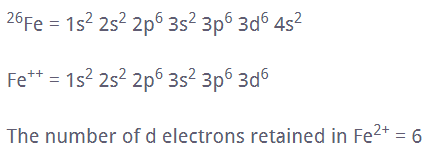


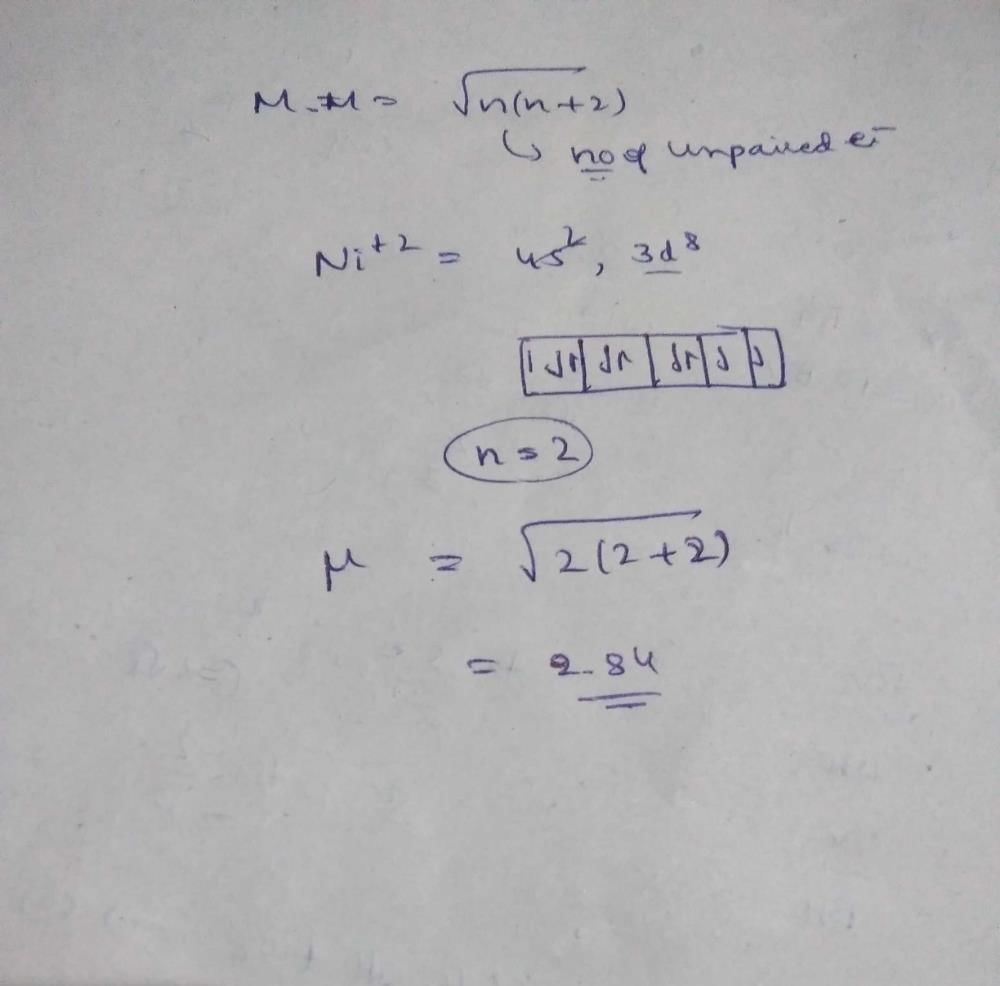
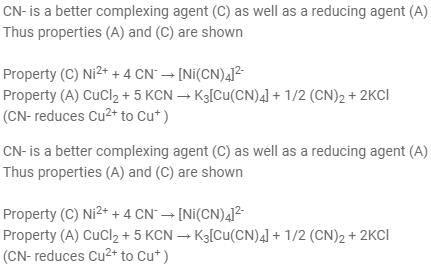 Thus correct option is A
Thus correct option is A






